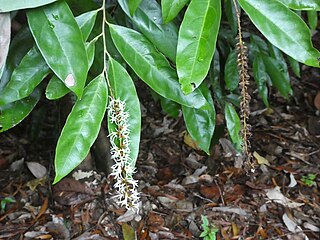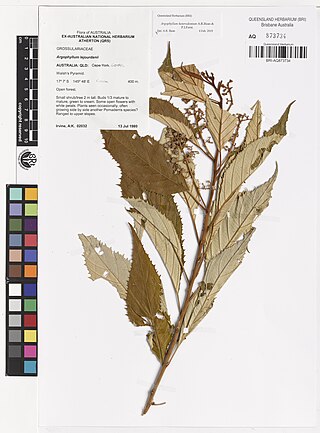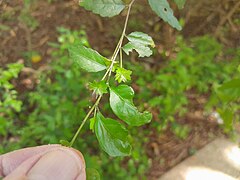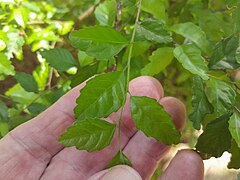
Helicia australasica, also known as Austral oak or creek silky oak, is a species of rainforest tree in the macadamia family Proteaceae, native to New Guinea and northern and northeastern Australia.

Phaleria clerodendron, commonly known as scented daphne, scented phaleria or rosy apple, is an evergreen tree or tall shrub in the family Thymelaeaceae. It is endemic to the rainforests of north-eastern Queensland, Australia.

Phyllanthus microcladus, commonly known as the brush sauropus or small-leaved Phyllanthus, is a plant in the family Phyllanthaceae found in tropical and sub tropical areas of eastern Queensland and northeastern New South Wales in Australia. It is listed as endangered in New South Wales, but in Queensland it is assessed as least concern. It occurs by streams in rainforest, from near Grafton northwards to around Cairns.

Syzygium alliiligneum, commonly known as onionwood, Mission Beach satinash or bark in the wood is a species of plant in the family Myrtaceae. It is endemic to a small part of north eastern Queensland.

Melicope rubra, commonly known as the little evodia, is a species of small tree in the citrus family Rutaceae, native to New Guinea and northeast Queensland. It was originally described as Euodia rubra in 1900. It has trifoliate leaves and pink bisexual flowers arranged on branches below the leaves.

Gardenia actinocarpa is a rare and endangered plant in the coffee and gardenia family Rubiaceae, native to a very restricted area within the Wet Tropics rainforest of northeastern Queensland.

Neostrearia is a monotypic genus - i.e. a genus containing only one species - of plants in the witch-hazel family Hamamelidaceae. It is the second described of three monotypic Australian genera in this family, the others being Ostrearia and Noahdendron. It is most closely related to these genera, as well as Trichocladus from southern Africa and Dicoryphe from Madagascar, and together these five genera form a distinct clade within Hamamelidaceae.

Argophyllum curtum is a plant in the Argophyllaceae family endemic to a small part of north eastern Queensland. It was described and named in 2018.

Argophyllum heterodontum is a plant in the Argophyllaceae family endemic to a small part of north eastern Queensland. It has an affinity to A. lejourdanii and was described and named in 2018.

Mackinlaya macrosciadea, commonly known as mackinlaya or blue umbrella, is a plant in the carrot, fennel and parsley family Apiaceae, found in the Northern Territory and Queensland, Australia.

Diploglottis harpullioides, commonly known as Babinda tamarind, is a rainforest tree in the lychee and maple family Sapindaceae which is found only in northeast Queensland, Australia.

Alyxia oblongata, commonly known as the chain fruit, prickly lixy, or prickly Alyxia, is a plant in the dogbane family Apocynaceae endemic to a small part of northeastern Queensland.

Fagraea fagraeacea, commonly known as yellowheart or pink jitta, is a plant in the gentian family Gentianaceae which is native to New Guinea and Queensland.

Rubus queenslandicus, commonly known as bramble-of-the-cape, rose-leaf bramble, or native raspberry, is a plant in the rose family Rosaceae which is endemic to a small part of northeastern Queensland, Australia, where it is found on the margins of highland forest. Prior to 1997, collections of this plant were identified as either R. rosifolius, R. fraxinifolius or R. muelleri/R. probus.

Argophyllum cryptophlebum is a plant in the Argophyllaceae family of the order Asterales, which is endemic to a small part of north eastern Queensland. It was described and named in 1907.

Cupaniopsis flagelliformis, commonly known as brown tuckeroo or weeping flower tamarind, is a tree in the lychee and maple family Sapindaceae endemic to eastern Australia. It is a small tree that inhabits drier or seasonal rainforests.

Diploglottis bernieana, commonly known as Bernie's tamarind or large leaf tamarind, is a plant in the maple and lychee family Sapindaceae. It was first described in 1987 by the Australian botanist Sally T. Reynolds and is found only the Wet Tropics region of northeastern Queensland, Australia.

Peripentadenia mearsii, commonly known as the buff quandong or grey quandong, is a plant in the family Elaeocarpaceae endemic to a small part of northeastern Queensland, Australia. It is usually seen as a multistemmed tree, and the habitat is tropical rainforest.

Actephila foetida is a plant in the family Phyllanthaceae that is found only in a very restricted range within the Wet Tropics bioregion of Queensland, Australia. It was first described in 1927.

Peperomia enervis is a plant in the pepper family Piperaceae found only in rainforests of northeast Queensland near the cities of Cairns and Mackay. It was first described in 1891.
























